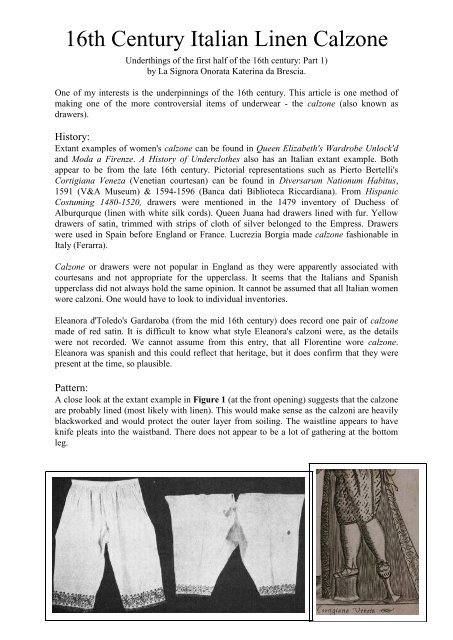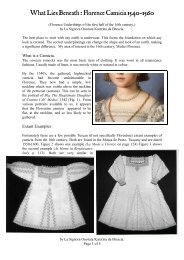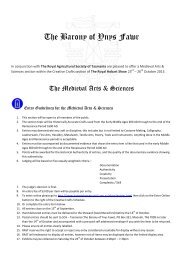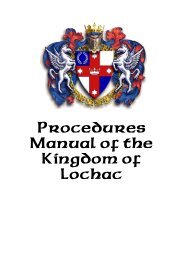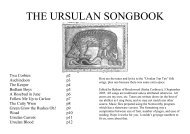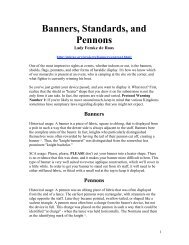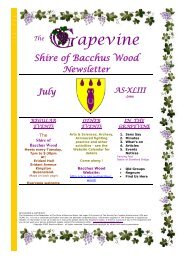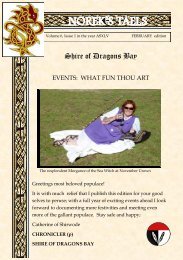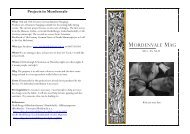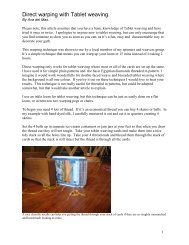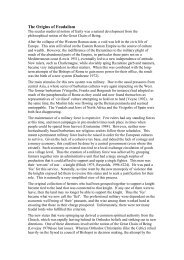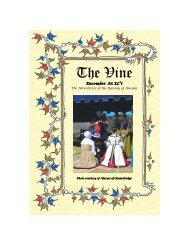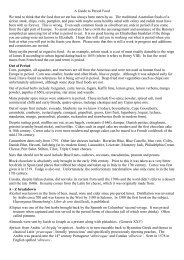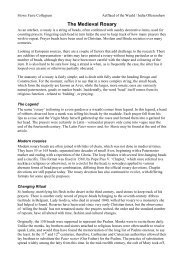16th Century Italian Linen Calzone
16th Century Italian Linen Calzone
16th Century Italian Linen Calzone
Create successful ePaper yourself
Turn your PDF publications into a flip-book with our unique Google optimized e-Paper software.
<strong>16th</strong> <strong>Century</strong> <strong>Italian</strong> <strong>Linen</strong> <strong>Calzone</strong><br />
Underthings of the first half of the <strong>16th</strong> century: Part 1)<br />
by La Signora Onorata Katerina da Brescia.<br />
One of my interests is the underpinnings of the <strong>16th</strong> century. This article is one method of<br />
making one of the more controversial items of underwear - the calzone (also known as<br />
drawers).<br />
History:<br />
Extant examples of women's calzone can be found in Queen Elizabeth's Wardrobe Unlock'd<br />
and Moda a Firenze. A History of Underclothes also has an <strong>Italian</strong> extant example. Both<br />
appear to be from the late <strong>16th</strong> century. Pictorial representations such as Pierto Bertelli's<br />
Cortigiana Veneza (Venetian courtesan) can be found in Diversarum Nationum Habitus,<br />
1591 (V&A Museum) & 1594-1596 (Banca dati Biblioteca Riccardiana). From Hispanic<br />
Costuming 1480-1520, drawers were mentioned in the 1479 inventory of Duchess of<br />
Alburqurque (linen with white silk cords). Queen Juana had drawers lined with fur. Yellow<br />
drawers of satin, trimmed with strips of cloth of silver belonged to the Empress. Drawers<br />
were used in Spain before England or France. Lucrezia Borgia made calzone fashionable in<br />
Italy (Ferarra).<br />
<strong>Calzone</strong> or drawers were not popular in England as they were apparently associated with<br />
courtesans and not appropriate for the upperclass. It seems that the <strong>Italian</strong>s and Spanish<br />
upperclass did not always hold the same opinion. It cannot be assumed that all <strong>Italian</strong> women<br />
wore calzoni. One would have to look to individual inventories.<br />
Eleanora d'Toledo's Gardaroba (from the mid <strong>16th</strong> century) does record one pair of calzone<br />
made of red satin. It is difficult to know what style Eleanora's calzoni were, as the details<br />
were not recorded. We cannot assume from this entry, that all Florentine wore calzone.<br />
Eleanora was spanish and this could reflect that heritage, but it does confirm that they were<br />
present at the time, so plausible.<br />
Pattern:<br />
A close look at the extant example in Figure 1 (at the front opening) suggests that the calzone<br />
are probably lined (most likely with linen). This would make sense as the calzoni are heavily<br />
blackworked and would protect the outer layer from soiling. The waistline appears to have<br />
knife pleats into the waistband. There does not appear to be a lot of gathering at the bottom<br />
leg.
<strong>16th</strong> <strong>Century</strong> <strong>Italian</strong> <strong>Linen</strong> <strong>Calzone</strong><br />
Both <strong>Italian</strong> examples, in Figure 2, do not have a gathered leg at the bottom. The one on the<br />
left has the waistband ungathered. This allows us to see more clearly how the shapes of the<br />
pieces used to construct these calzone.<br />
Based on Figures 1 and 3, my pattern has an angled leg pattern, with gussets for the crotch, as<br />
seen in Figures 4 and 5. The waist is pleated to the waistband. The shape can be better seen in<br />
Figure 3, from Diversarum Nationum Habitus. The lower leg can be finished in a cuff or ties,<br />
as seen in Figures 1 and 3. A wider lower leg will give a pattern more suitable for calzoni as<br />
seen in Figure 2.
<strong>16th</strong> <strong>Century</strong> <strong>Italian</strong> <strong>Linen</strong> <strong>Calzone</strong><br />
Bibliography:<br />
1. Anderson, Ruth Mathilde. Hispanic Costuming 1480-1520 p 215 (supplied by Mistress<br />
Constanzia de Zamora)<br />
2. Arnold Janet, Queen Elizabeth's Wardrobe Unlock'd, Maney, Leeds, 1988, ISBN:0-<br />
901286-20-6<br />
3. Kovesi Killerby, Catherine, Sumptuary Law in Italy 1200-1500, Oxford University Press.<br />
NY. 2002. ISBN:0-19-924793-5<br />
4. Crowfoot E, Pritchard F & Staniland K, Textiles and Clothing 1150-1450, Boydell Press,<br />
Woodridge, 2001 (ed) ISBN: 0-85115-840-4<br />
5. Frick, Carole Collier. Dressing Renaissance Florence.: Families Fortunes & Clothing.<br />
John Hopkins University Press. Baltimore. 2002. ISBN: 0-8018-6939-0<br />
6. Fennel Mazzoui, Maureen. The <strong>Italian</strong> Cotton Industry in the Later Middles Ages 1100-<br />
1600, Cambridge University press, 1981. (thanks to Galiana de Baiona).<br />
7. Orsi Landini, Roberta & Niccoli, Bruna. Moda a Firenze 1540-1580. Pagliai Polistampa,<br />
Firenze, 2005. ISBN: 88-8304-867-9<br />
8. Veccellio, Cesare. Vecellio's renaissance Costume Book. Dover Publications. NY. 1977.<br />
ISBN: 0 48623441X<br />
9. Willet, C. & Cunnington, Phillis, A History of Underclothes, Dover Publications, NY,<br />
1992, ISBN: 0-486-27124-2<br />
Web Sites:<br />
1. V&A Museum website: http://images.vam.ac.uk<br />
2. Bath Museum of Costume: http://www.museumofcostume.co.uk/<br />
http://www.museumofcostume.co.uk/index.cfmfuseAction=SM.nav&UUID=013DFA14-<br />
32A6-4A33-B3CDA4E8E00C9D49)<br />
3. Warwickshire Museum Website www.datavista.co.uk<br />
4. Diversarum nationum habitus -<br />
http://www.istitutodatini.it/biblio/images/riccard/12886/htm/vol1.htm<br />
5. Oonagh's Own: http://oonagh.actewagl.net.au/<br />
6. "How much yardage is enough" Susan Reed, 1994.<br />
http://patriot.net/~nachtanz/SReed/fabuse.html<br />
7. Suggested Yardages for Elizabethan Garments by Drae Leed.<br />
http://costume.dm.net/yardages.html# (29/5/03)


